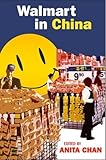Walmart in China / ed. by Anita Chan.
Material type: TextPublisher: Ithaca, NY : Cornell University Press, [2011]Copyright date: ©2011Description: 1 online resource (304 p.) : 5 halftones, 10 tables, 8 charts/graphsContent type:
TextPublisher: Ithaca, NY : Cornell University Press, [2011]Copyright date: ©2011Description: 1 online resource (304 p.) : 5 halftones, 10 tables, 8 charts/graphsContent type: - 9780801450204
- 9780801462672
- 381.149
- HF5429.215.C6 W35 2011
- online - DeGruyter
- Issued also in print.
| Item type | Current library | Call number | URL | Status | Notes | Barcode | |
|---|---|---|---|---|---|---|---|
 eBook
eBook
|
Biblioteca "Angelicum" Pont. Univ. S.Tommaso d'Aquino Nuvola online | online - DeGruyter (Browse shelf(Opens below)) | Online access | Not for loan (Accesso limitato) | Accesso per gli utenti autorizzati / Access for authorized users | (dgr)9780801462672 |
Frontmatter -- CONTENTS -- List of Abbreviations -- Introduction: When the World's Largest Company Encounters the World's Biggest Country -- Part One: The Walmart Supply Chain -- 1. Walmart's Long March to China: How a Mid-American Retailer Came to Stake Its Future on the Chinese Economy -- 2. Outsourcing in China: Walmart and Chinese Manufacturers -- 3. Walmartization, Corporate Social Responsibility, and the Labor Standards of Toy Factories in South China -- 4. Made in China: Work and Wages in Walmart Supplier Factories -- Part Two: The Walmart Stores -- 5. Corporate Cadres: Management and Corporate Culture at Walmart China -- 6. A Store Manager's Success Story -- 7. Practicing Cheer: The Diary of a Low-Level Supervisor at a Walmart China Store -- 8. Working in Walmart, Kunming: Technology, Outsourcing, and Retail Globalization -- Part Three: Walmart Trade Unions -- 9. Unionizing Chinese Walmart Stores -- 10. Did Unionization Make a Difference? Work Conditions and Trade Union Activities at Chinese Walmart Stores -- 11. Workers and Communities versus Walmart: A Comparison of Organized Resistance in the United States and China -- Notes -- Notes on Contributors -- Index
restricted access online access with authorization star
http://purl.org/coar/access_right/c_16ec
Walmart and "Made in China" are practically synonymous; Walmart imports some 70 percent of its merchandise from China. Walmart is now also rapidly becoming a major retail presence there, with close to two hundred Walmarts in more than a hundred Chinese cities. What happens when the world's biggest retailer and the world's biggest country do business with each other? In this book, a group of thirteen experts from several disciplines examine the symbiotic but strained relationship between these giants. The book shows how Walmart began cutting costs by bypassing its American suppliers and sourcing directly from Asia and how Walmart's sheer size has trumped all other multinationals in squeezing procurement prices and, as a by-product, driving down Chinese workers' wages.China is also an inviting frontier for Walmart's global superstore expansion. As China's middle class grows, the chain's Western image and affordable goods have become popular. Walmart's Arkansas headquarters exports to the Chinese stores a unique corporate culture and management ideology, which oddly enough are reminiscent of Mao-era Chinese techniques for promoting loyalty. Three chapters separately detail the lives of a Walmart store manager, a lower-level store supervisor, and a cashier. Another chapter focuses on employees' wages, "voluntary" overtime, and the stores' strict labor discipline. In 2006, the official Chinese trade union targeted Walmart, which is antilabor in its home country, and succeeded in setting up union branches in all the stores. Walmart in China reveals the surprising outcome.Contributors: Diana Beaumont, coeditor of China Labor News Translations; Anita Chan, University of Technology, Sydney; David J. Davies, Hamline University; Nelson Lichtenstein, University of California, Santa Barbara; Scott E. Myers, Monterey Institute of International Studies; Eileen Otis, University of Oregon; Pun Ngai, Hong Kong Polytechnic University; Katie Quan, University of California, Berkeley; Taylor Seeman, Hamline University; Kaxton Siu, Australian National University; Jonathan Unger, Australian National University; Xue Hong, East China Normal University; Yu Xiaomin, Beijing Normal University
Issued also in print.
Mode of access: Internet via World Wide Web.
In English.
Description based on online resource; title from PDF title page (publisher's Web site, viewed 02. Mrz 2022)


